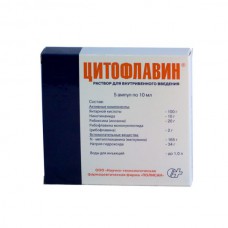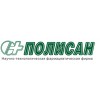Expiration date: 06/2025
The composition and form of issue:
The intravenous solution. 1 ml contains:
succinic acid 100 mg
nicotinamide 10 mg
Riboxin (inosine) 20 mg
Riboflavin mononucleotide (Riboflavin) 2 mg
Excipients: N-methylglucamine (meglumine) — 165 mg sodium hydroxide — 34 mg water for injection
in brown glass ampoules of 10 ml, in a contour acheikova package 5 ampoules, in a cardboard unit 1 or 2 packages, or bottles of 5 ml in a cardboard pack 10 PCs.
Description pharmaceutical form:
The solution for the on/in the introduction: transparent liquid of yellow color.
Pharmacokinetics:
The on/in infusion at a rate of about 2 ml/min (in terms of undiluted Citoflavin) succinic acid and Riboxin (inosine) are utilized almost instantly and in plasma are not defined. Riboxin (inosine) is metabolized in the liver to form glucuronic acid and its subsequent oxidation. In small amounts excreted by the kidneys. Nicotinamide is rapidly distributed in all tissues, crosses placenta and in breast milk, metabolized in the liver with the formation of nicotinamide-N-methylnicotinamide and excreted by the kidneys. T1/2 from plasma is about 1.3 h, fixed volume of distribution — about 60 l, total clearance — about 0.6 l/min. Riboflavin is unevenly distributed — the highest number in the myocardium, liver, kidneys. T1/2 from plasma is about 2 h, the stationary volume of distribution is approximately 40 liters, the total clearance is about 0.3 l/min Penetrates through the placenta and into the mother's milk. The plasma protein binding is 60%. Excreted by the kidneys, partly in the form of the metabolite in high doses, mostly unaltered.
Description pharmacological action:
Stimulates respiration and energobrazovania in the cells, improves the processes of oxygen utilization by tissues, restores the activity of antioxidant enzymes. Activates intracellular protein synthesis, promotes glucose utilization, fatty acids and resynthesis of GABA in neurons through the shunt Roberts. Improves coronary and cerebral blood flow, activates metabolic processes in Central nervous system, restores consciousness, reflex disorders, disorders of sensitivity and intellectual-mnestic functions of the brain. Has a fast Wake-up action when poslenarkoznogo oppression of consciousness. At/in the application of Cytoflavin in the first 12 hours of the onset of stroke development, there is a reduction of foci of ischemic and necrotic processes in the affected area, restoration of neurological status and reducing disability in the long term.
Indications:
- acute disorders of cerebral circulation
- dyscirculatory (vascular) encephalopathy 1-2 and the consequences of violations of cerebral circulation (chronic ischemia of brain)
- toxic and hypoxic encephalopathy in acute and chronic poisoning, endotoxicosis, poslenarkoznogo oppression of consciousness.
- in children (including premature infants with gestational age 28-36 weeks) in the treatment of cerebral ischemia in neonatal period.
Contraindications:
- individual intolerance of the drug components
- pregnancy
- lactation.
Not prescribed to patients (excluding the neonatal period), are in critical condition, to the stabilization of Central hemodynamics and/or by reducing the partial pressure of oxygen in arterial blood less than 60 mm Hg. article
With caution:
nephrolithiasis gout hyperuricemia.
Application of pregnancy and breast-feeding:
Perhaps the use during pregnancy in the absence of allergic reactions to the drug components.
Side effects:
With rapid infusion may cause harmful reactions, not requiring discontinuation of the drug are: flushing of the skin of varying severity, feeling hot, bitter and dry mouth, sore throat. In the long admission high doses possible transient hypoglycemia, hyperuricemia, the worsening gout. To rare adverse reactions include: transient pain and discomfort in the epigastric region and the chest, shortness of breath, nausea, headache, dizziness, "tingling" in the nose, dysosmia, blanching of the skin of varying severity. Also possible allergic reactions in form of itching.
Drug interactions:
Succinic acid, inosine, nicotinamide compatible with other drugs. The product is compatible with drugs stimulating hemopoiesis, antihypoxic, anabolic steroids. Reduces and prevents side effects of chloramphenicol (violation gemopoaiza, optic neuritis).
Riboflavin reduces the activity of doxycycline, tetracycline, oxytetracycline, erythromycin and lincomycin. Incompatible with streptomycin. Chlorpromazine, imipramine, amitriptyline, due to the blockade of flavinokinaza violate the inclusion of Riboflavin in flavinadeninnukleotid and flavinadeninnukleotid and increase its excretion in the urine. Thyroid hormones accelerate the metabolism of Riboflavin.
Method of application and dose:
In/in the drip.
Adults:
Citoflavin apply only in/drip in breeding 100-200 ml 5-10% solution dekstrozy or 0.9% solution of sodium chloride.
1. In acute violation of cerebral circulation the drug is administered as early as possible from the beginning of the development of the disease in the amount of 10 ml per administration with an interval of 8-12 hours for 10 days. In severe form of the disease, a single dose of 20 ml.
2. The consequences of cerebrovascular diseases (consequences of cerebral infarction, cerebral atherosclerosis) the drug is administered in a volume of 10 ml to the introduction of 1 times a day for 10 days.
3. When toxic and hypoxic encephalopathy the drug is administered in a volume of 10 ml administered 2 times a day 8-12 hours for 5 days. When coma in a volume of 20 ml per administration in dilution with 200 ml of dextrose solution. When you post anesthetic depression once in the same doses. In the treatment of hypoxic encephalopathy after cardiac surgery with use of cardiopulmonary bypass is administered at 20 ml in dilution with 200 ml of 5% dextrose solution for 3 days before surgery, on the day of surgery, 3 days after surgery.
In children (including premature infants) in the neonatal period with cerebral ischemia daily dose of the drug Cytoflavin is 2 ml/kg/day. Calculated daily dose of the drug is injected in/in the drip (slowly) after dilution in 5 or 10% dextrose solution (in a ratio of at least 1:5). The time of the first introduction — the first 12 hours after birth is the optimal time to initiate therapy are the first 2 hours of life. It is recommended to introduce the prepared solution via infusion pump at a rate of 1 to 4 ml/h, providing a uniform release of the drug into the bloodstream during the day, depending on the estimated daily total solutions for the basic treatment, hemodynamic conditions of the patient and the parameters of acid-base status. The course of treatment is average 5 days.
Special instructions:
Introduction of newborn (premature babies) children under the control of the parameters of acid-base status of capillary blood at least 2 times a day (before and during the treatment). If possible, you should control the rate of serum lactate and glucose.
The rate of introduction of the solution containing Cytoflavin, decrease or temporarily stop the infusion in newborn infants (premature) children:
being on a ventilator with signs of mixed (respiratory and metabolic) alkalosis, threatened by the development of disorders of cerebral circulation
- while maintaining spontaneous breathing and respiratory support with CPAP method, or receives an air-oxygen mixture through a mask with the appearance of laboratory signs of metabolic alkalosis, threatened by the appearance or increased frequency of seizures, apnea.
In patients with diabetes mellitus treatment is carried out under the monitoring of indicators of blood glucose.
Perhaps the intense staining of urine yellow.
Citoflavin no effect on the ability to drive vehicles.



